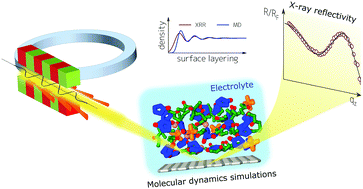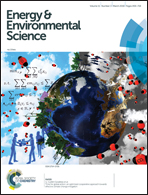The nanoscale structure of the electrolyte–metal oxide interface†
Abstract
Electrolyte ordering near solid surfaces is of vital importance in diverse fields, ranging from physical chemistry, to energy storage, and heterogeneous catalysis. However, experimental determination of the structure of the electrode–electrolyte interface and electric double layer is challenging due to limited experimental approaches. In this work we show a detailed picture of the electrode–electrolyte interface relevant to Li-ion batteries. Specifically, we probe the atomic-scale interfacial structure of a non-aqueous liquid electrolyte solution of ethylene carbonate (EC) and dimethyl carbonate (DMC) containing lithium hexafluorophosphate (LiPF6) salt via surface sensitive Ångstrom resolution X-ray reflectivity (XRR). We complement our experimental results with molecular dynamics (MD) simulations, and find good agreement between the experiment and simulation derived density profiles. The surface at open circuit voltage (OCV) induces layering of electrolyte molecules near the interface, which decays towards the bulk, and we conclude that both EC and DMC molecules in the first interfacial layer tend to adsorb parallel to the surface. With increasing salt-concentration, the layering periodicity and the degree of order increase. We discuss implications of our results to Li-ion batteries, with focus on the relation between interfacial structure and ion transport in and out of the electrode.

- This article is part of the themed collection: 2018 Energy and Environmental Science HOT Articles


 Please wait while we load your content...
Please wait while we load your content...